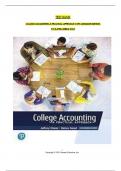Exam (elaborations)
Complete Test Bank Saunders Comprehensive Review for the NCLEX-PN Examination 6th Edition Linda Anne Silvestri Questions & Answers with rationales (Chapter 6-66)
Saunders Comprehensive Review for the NCLEX-PN Examination 6th Edition Linda Anne Silvestri Test Bank Complete Test Bank Saunders Comprehensive Review for the NCLEX-PN Examination 6th Edition Linda Anne Silvestri Questions & Answers with rationales (Chapter 6-66) PDF File All Pages All Cha...
[Show more]












